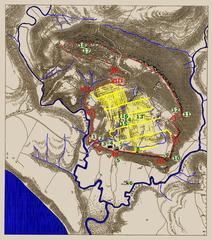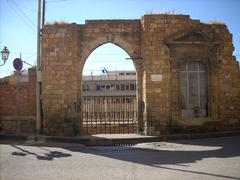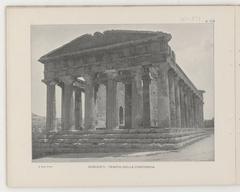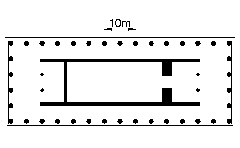Porta V Agrigento: Comprehensive Visiting Guide, Tickets, and Historical Insights
Date: 14/06/2025
Introduction
Porta V, also referred to as the Fifth Gate or Porta Quinta, is a historically significant gateway marking the western entrance to Agrigento’s renowned Valley of the Temples (Valle dei Templi) in Sicily. Dating back to the 6th century BCE as part of the ancient Greek city of Akragas, Porta V stands as a testament to the city’s defensive ingenuity, urban planning, and cultural identity. Today, this well-preserved gate not only serves as a principal access point for visitors but also connects modern explorers to a layered history spanning Greek, Roman, and early Christian eras.
This guide offers a detailed overview of Porta V, covering its history, architectural features, strategic significance, visitor information (including hours and ticketing), accessibility, travel tips, nearby attractions, and frequently asked questions. Whether you are planning your first visit or seeking in-depth historical context, this resource will help you make the most of your journey through one of Sicily’s most iconic archaeological landmarks.
For authoritative information and planning resources, see The World of Sicily, Voyage Tips, and the official Valley of the Temples website.
Table of Contents
- Introduction
- Origins and Construction of Porta V
- Strategic and Urban Significance
- Archaeological Discoveries and Features
- Historical Events and Transformations
- Preservation and Modern-Day Context
- Visitor Information
- Nearby Attractions and Events
- Cultural and Symbolic Legacy
- FAQs
- Visuals and Media Suggestions
- Internal Links
- Conclusion and Recommendations
Origins and Construction of Porta V
Porta V is one of the best-preserved gates of ancient Akragas, founded by Greek settlers around 580 BCE (The World of Sicily). The fortifications of Akragas formed a 12-kilometer perimeter adapted to the natural terrain, with nine strategically placed gates. Porta V, classified as a “Scee Gate,” featured an oblique entrance designed to expose enemy combatants’ unshielded sides, a tactical innovation reflecting the military expertise of its builders.
The gate was constructed using large blocks of local limestone, and archaeological evidence suggests it originally had flanking towers or bastions to enhance defense. Its design not only fulfilled military functions but also demonstrated the urban planning sophistication characteristic of Greek city-states.
Strategic and Urban Significance
Porta V’s location was pivotal in the city’s defensive and civic layout. It granted access to the Sanctuary of the Chthonic Deities and linked the city’s main artery (platiea) to the Agora and other gates. This critical connection facilitated religious ceremonies, trade, and daily urban activities.
The southern fortification walls, where Porta V is located, were particularly significant due to their proximity to the Valley’s major temples. These walls underwent several renovations, especially after 339 BCE, reflecting the city’s resilience and adaptability in the face of shifting political circumstances (The World of Sicily).
Archaeological Discoveries and Features
Excavations near Porta V have uncovered a hypogeum associated with the Garden of Kolymbethra—a lush oasis irrigated by ancient aqueducts and cisterns (The World of Sicily). This area demonstrates the advanced engineering skills of the ancient city’s inhabitants.
Additionally, the southern walls near Porta V contain early Christian arcosolium tombs, attesting to the site’s use and adaptation through Roman and Byzantine periods.
Historical Events and Transformations
Akragas reached its height in the 5th century BCE but was besieged by Carthaginians in 406 BCE, during which the city’s gates and fortifications played critical roles (DitisItalie.nl). The city later came under Roman control in 210 BCE, maintaining and adapting its defensive structures. The presence of Christian burials indicates ongoing transformation of the site into the early medieval era.
Preservation and Modern-Day Context
Porta V has survived largely intact thanks to its robust construction and relatively undisturbed setting. Today, it serves as a main entrance to the Valley of the Temples archaeological park, located near a large parking area and the Archaeological Museum “Pietro Griffo” (DitisItalie.nl). Its preservation allows visitors to experience firsthand the engineering and architectural prowess of ancient Sicily.
Visitor Information
Visiting Hours
- Summer (April – October): 8:30 AM – 7:30 PM (last entry 6:30 PM)
- Winter (November – March): 8:30 AM – 5:30 PM (last entry 4:30 PM)
- Peak Summer Months: The park, including Porta V, may remain open until 11:00 PM for illuminated night visits.
- Always verify hours on the official website before visiting.
Tickets and Prices
- Standard Entry: €17 per adult (as of 2025)
- Concessions: Reduced rates for students and seniors
- Combined Tickets: Valley + Archaeological Museum “Pietro Griffo” for €15.50
- Free Entry: First Sunday of each month
- Tickets are available at Porta V or online for skip-the-line access (Voyage Tips).
Accessibility
Porta V is the most accessible entrance, featuring ramps bypassing steps (9% and 4% inclines). The park’s terrain is uneven, so visitors with mobility challenges may require assistance. Shuttle services (€3) connect Porta V with the eastern entrance, reducing walking distances (Visit Valle dei Templi).
Travel Tips
- Getting There:
- By Car: Large parking lot 110 meters from Porta V entrance.
- By Public Transport: Bus Line 1 from Agrigento center/train station to Porta V; tickets €1.70 one way (Go Ask a Local).
- On Foot: Scenic 3 km walk from central Agrigento, mostly downhill.
- Facilities: Ticket office, restrooms, water fountains, snack bars, and shaded benches.
- Best Time to Visit: Early morning or late afternoon to avoid heat and crowds. Spring and autumn offer the most pleasant climate.
- Recommended Itinerary: Park at Porta V, shuttle to Porta di Giunone (east entrance), and walk back westward, visiting major temples along the way.
- Guided Tours: Available and highly recommended for historical context.
Nearby Attractions and Events
- Garden of Kolymbethra: A verdant botanical garden accessible from Porta V (Untold Morsels).
- Archaeological Museum “Pietro Griffo”: Houses artifacts and statues from the Valley (Italia.it).
- Agrigento Old Town: Features picturesque streets and traditional Sicilian cuisine (Savoring Italy).
- Scala dei Turchi: Famous limestone cliffs and beach, 15-minute drive from the Valley (Voyage Tips).
- 2025 Capital of Culture Events: Agrigento’s designation brings special exhibitions and performances; check the official site for updates.
Cultural and Symbolic Legacy
Porta V is more than a defensive structure; it represents the intersection of military, religious, and civic life in ancient Akragas. Its enduring presence bridges Greek, Roman, and Christian influences, symbolizing the resilience and multicultural heritage of Agrigento (The World of Sicily).
Frequently Asked Questions (FAQ)
Q: What are the Porta V visiting hours?
A: Typically 8:30 AM – 7:30 PM in summer, 8:30 AM – 5:30 PM in winter. Extended summer hours for night visits.
Q: How do I buy tickets for Porta V?
A: At the entrance or online. Combined museum/park tickets are available.
Q: Is Porta V accessible for wheelchair users?
A: Yes, with ramps bypassing steps. Some assistance may be needed due to gradients.
Q: Are guided tours available?
A: Yes, guided tours and audio guides can be booked for a richer experience.
Q: Can I park near Porta V?
A: Yes, the largest parking area is just 110 meters from the gate.
Visuals and Media Suggestions
- Include high-resolution images of Porta V, the Valley of the Temples, Temple of Concordia, and the Garden of Kolymbethra.
- Alt tags: “Porta V ancient gate in Agrigento,” “Valley of the Temples entrance at Porta V.”
- Explore virtual tours and interactive maps on the official website.
Internal Links
- [Temple of Concordia: History and Visitor Guide]
- [Ancient City Walls of Akragas: A Defensive Marvel]
- [Pietro Griffo Regional Archaeological Museum: A Treasure Trove of Artifacts]
- [Sicilian Archaeological Tours]
Conclusion and Recommendations
Porta V is an essential gateway for anyone seeking to explore the Valley of the Temples and the broader historical tapestry of Agrigento. Its blend of architectural innovation, strategic placement, and cultural resonance offers a unique lens into Sicily’s ancient civilizations. With convenient access, comprehensive visitor facilities, and the opportunity to participate in special events during Agrigento’s year as Italian Capital of Culture, Porta V is a must-see destination.
Plan your visit by checking current hours and ticketing, consider booking a guided tour for deeper insight, and make use of the Audiala app for audio tours and real-time updates. For further planning and travel inspiration, consult The World of Sicily, Voyage Tips, and the official Valley of the Temples website.
References
- The World of Sicily
- Voyage Tips
- Italia.it
- Earth Trekkers
- DitisItalie.nl
- Go Ask a Local
- Untold Morsels
- Visit Valle dei Templi
- Eternal Arrival
- Savoring Italy
- Great Sicily
- Traveling Italian





